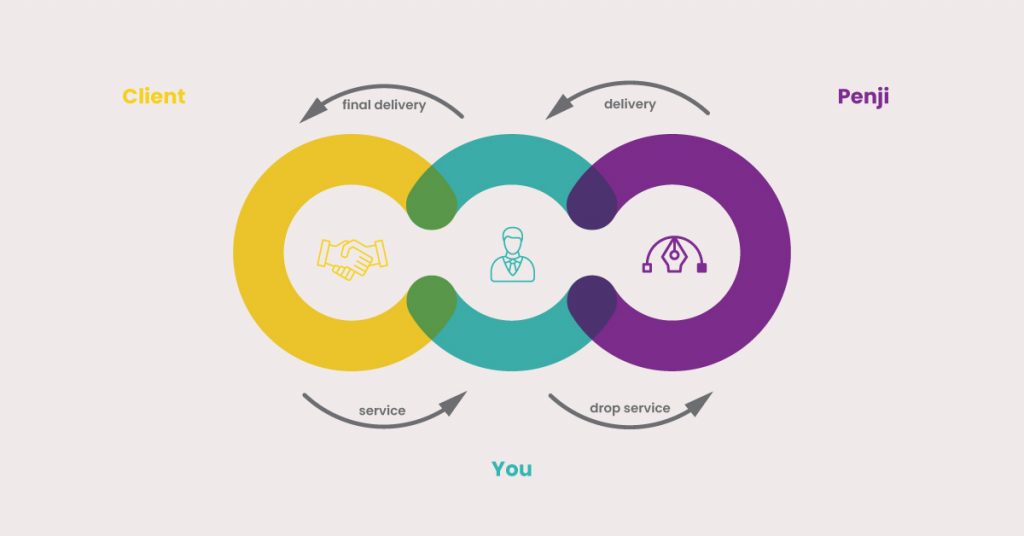
Looking for a profitable business but tight on resources? Drop servicing might be the answer you need. It’s all about selling a service to your customers and having someone else do the work for you. You might not know it, but drop servicing has been around for a while, and it’s a proven way to make money.
Let’s get to know what drop servicing is and how you can start yours.
What is Drop Servicing?

Those exploring their options in starting an online business will find drop servicing an excellent choice. It has the potential for a good stream of income without having huge capital. Plus, it may be the easiest as you only need to manage a team, find clients, and deliver the service from the comforts of your sofa.
Fundamentally, drop servicing is the business model wherein you sell a service and delegate it to a team of freelancers or agencies. You sell the service at a higher price than what you pay your team, thus making a profit. You may have heard about it, but with different names—service arbitrage and white labeling.
In a nutshell, drop servicing means outsourcing the work or reselling the service. You play the role of a middleman, a liaison officer, a go-between, or a broker. You find clients and provide the service, which will be completed by a team that charges you for less.
Some Examples of Drop Servicing
To further illustrate what drop servicing is, here are a few examples:
Content Writing
A great example would be a content writing service. You sell your client a blog package worth $1,000 inclusive of 15 articles. You then pass on the writing to your team of writers and pay them $700, pocketing the $300 payment difference.
Social Media Management
You find clients who need people to manage their company’s social media platforms. Then, you delegate the content creation to your freelancer or team. You then send the finished work to the client.
Bakery
People order customized cakes from your online baking shop. Instead of baking the cake yourself, you order it from a local baker and then deliver it to your customer.
Creative Agency
A client orders a TV commercial from you. You then pay a production company to make one and deliver it to your client.
Dry Cleaning
A customer comes to you to have their dress dry-cleaned. You send the dress to a cleaning company. After it’s cleaned, you send it back to your customer.
As you can see from the above examples, drop servicing isn’t limited to digital products. The concept is not something new, as it has been around in the real world longer. And it has been reaping success for many business owners and entrepreneurs.
Here are other examples of services that you can do for your drop servicing business:
- Graphic design
- Website creation
- Search Engine Optimization (SEO)
- Virtual assistance
- Copywriting
- Video editing
- Voiceover work
The Difference Between Drop Servicing and Dropshipping

Now, you may confuse drop servicing with the business of dropshipping. Dropshipping is a commonly heard term, even if most people do not understand what it is. Let’s define it and learn what their differences are.
Dropshipping is the practice of selling physical products even if you don’t have a warehouse to store your inventory. You will sell to your clients, and your supplier will send the goods to them directly. As with drop servicing, you only act as the middleman.
So yes, dropshipping and drop servicing are the same, but with different items to sell. To sum it up, drop servicing is to services, while dropshipping is to physical products.
How to Start Your Drop Servicing Business

Drop servicing is a relatively easy and high-profit business, but there are a few things you need to know before starting one. While drop servicing is legal, some people see it as morally ambiguous. They may find it hard to learn that you aren’t handling the service yourself.
To avoid this, you have to be upfront with your business processes and let your customers know about them. Assure them that your team can provide the service you promise. Ensure that they know that you take full responsibility for all your deliverables.
In addition, it’s true that you don’t have to be an expert in your chosen drop servicing niche. But you can’t just start one without ample knowledge about it. It would be challenging to create a drop servicing business where you don’t know anything. This can affect the quality of service you provide, resulting in disgruntled customers.
That being said, let’s get started. Here is a step-by-step guide to creating your own drop servicing business:
Identify Your Niche

First off, you need to choose which niche you want your drop servicing to be in. As discussed earlier, it has to be one where you have substantial knowledge. It would be easy to get lost managing a business you know little about.
If you are unsure where to start, ask yourself the following questions:
- What do I know?
- What am I good at?
- Which concept can I efficiently work on and build?
- What am I most interested in?
- Which idea has the most potential for high revenues?
After getting the answers to these questions, it’s also crucial to determine what is in demand and what the market needs.
Do Your Research

To know what is in demand and what the market needs are, you need to do some research. Gather as much information as you can about the niche you have chosen for yourself. Learn about your prospects, their pain points, and how you can provide the service they need.
The internet offers many possibilities for conducting market research. You can read and update yourself with news, blogs, and case studies. You can also interview potential customers to get a feel for what they need that you can offer and many other ways to gain information.
Build Your Team

This is critical as your team will be the foundation of your business. Your team members will be the ones to execute your service, so you need to choose them carefully. Make sure that they can do the job well, as it is your name and reputation that’s on the line in your business.
There are many websites you can go to when searching for freelancers. A few good examples are Toptal, Upwork, Freelancer, and Guru. It also helps to check out universities and colleges in your neighborhood as you can find students willing to work as trainees or apprentices. Better yet, you can work with on-demand service providers, as this business structure is also prevalent nowadays.
Here are a few vital tips that can help you when searching for a freelancer or third-party service provider for your team:
- If you are looking for creatives, ask for a portfolio. This is an excellent gauge to know if their work will fit right in your business.
- Ask for references. Contact their past employers or clients to get an idea of their work ethics.
- Review their feedback if possible. Some online marketplace websites have feedback or review systems. Check them out to see what other people say about your prospect.
Additionally, it’s not farfetched to find applicants coming from various parts of the world. You need to take note of the time zones. This is in case you find some that take long in answering your correspondence.
Establish Your Brand

Once you have built your team and everyone is on the same page as you, it’s time to establish your brand. In today’s ultra-competitive world, it pays to have an online presence, whatever your business is. So for your drop servicing endeavor, you need to think about your website, brand identity and personality, and social media platforms.
But before that, you will need to think about branding, including logo design, company colors, and fonts. This is the face of your brand that your customers will remember you by. Ensure that it’s unique, eye-catching, and good for recall.
Let’s go back to building that website. You can go to website builders such as WordPress, Wix, and Weebly. You can also choose to hire a website designer. They can optimize your site to convert visitors into clients. Either way, make sure it’s well-designed and functional.
As for your social media presence, content is king. Craft social media graphics that will pique the interest of prospects and engage your customers. You need to make noise to get your brand to stand out.
Market Your Drop Servicing Business

It’s now time to let everybody know who you are and what your brand is about. Promote your drop servicing business and let customers find their way to your website. You can do the following strategies:
- Optimize your content – use SEO strategies on your website or hire someone to do it for you
- Advertise online – search engines and social media platforms offer free advertising if you don’t like the idea of paying for it
- Become visible on Google – Google My Business isn’t just for advertising, it also has analytics that can help you see how your business is doing
- Do email marketing – email is not dead as some may claim it to be. Build your database and keep them updated with news about your business
- Network in the digital community – joining online communities where you can network, learn from other business owners, and boost your online presence
There are so many more marketing strategies you can try. It’s a matter of experimenting with what will work best. Once you find those that work for you, don’t be afraid to explore other options to add variety to your arsenal.
Get Ready to Make Your First Sale

Now that you have ironed out everything you need to do, it’s time to get yourself ready to make that first sale. A positive attitude, a dedication to the business, and the eagerness to overcome challenges will lead you to success.
As you get more clients, you’ll gain experience, knowledge, and expertise, which will strengthen your brand and help you scale it. You’ll also learn the spots that need improvement and gain confidence in managing your business.
How Can Penji Help Your Drop Servicing Business
Did you know that Penji is also a drop servicing company? This is why we fully understand its concept, as we use this business model as well. We accept design requests from our clients and pass them on to our team of graphic designers. Once completed, we deliver the finished designs to our clients.
When starting your own drop servicing business, Penji can help you with your branding requirements. We can create your logo and website designs, social media graphics, and other marketing and branding materials you’ll need.
Plus, you may even work with Penji if you’re in the graphic design niche. If you’re planning to establish a graphic design drop service business, you can hire Penji as your third-party service provider. Ask your client for the design brief and put it in the queue on Penji’s custom design platform. Wait 24 to 48 hours, and submit the final output to your client! Here’s an image to better explain how it works:

Sign up today through this link to send your first design request.
Drop Servicing Business FAQs
What are some of the best strategies I can use for my drop servicing business?
There are many strategies you can employ when operating your drop servicing business. Below are the core essentials:
- Choose the most suitable niche you will focus on.
- Select partners who provide reliable and high-quality service.
- Develop competitive and transparent pricing strategies.
- Invest in professional and consistent branding visuals.
- Ensure that your drop servicing business complies with all legal and regulatory requirements.
- Provide efficient customer service.
How can I ensure quality control and customer satisfaction in my drop servicing business?
Quality control and customer satisfaction are paramount to any business wanting to succeed. Here are some key strategies you can do to achieve this:
- Choose your service providers wisely.
- Set clear expectations by communicating your project details.
- Always review the work for quality before you deliver.
- Define your quality standards and enforce them efficiently.
- Provide responsive customer service and support.
How do I manage customer inquiries, feedback, and disputes in my drop servicing Business?
Manage your business’ customer inquiries, feedback, and disputes by providing responsive and clear communications. Address customer questions promptly by giving them comprehensive answers. You may want to offer multiple contact channels to show your dedication to the business.
Encourage your customers to leave feedback that will help you understand and determine the areas that need improvement. Build and foster strong client relationships to build trust and gain their loyalty.
In cases of disputes, keep in mind to maintain professionalism every time. Gather information and facilitate open communications for both clients and service providers. Find and offer solutions that will benefit the interests of both parties.
What are the common struggles drop servicing business owners face?
The most common challenges and struggles drop servicing business owners face are the following:
- Finding trustworthy and high-quality service providers.
- Attracting clients as the market is one of the most competitive.
- Managing customer expectations regarding service delivery, timelines, and outcomes.
- Balancing your income and expenses, especially when you deal with client volumes that can go up and down without warning.
- Finding the right technology and tools to help you manage your projects, communication, and workflow.
- Handling customer disputes and ensuring that customers are happy with the service.
- Finding the right balance between work and life.
How can I effectively scale and grow my drop servicing business?
Scaling your drop servicing business effectively entails many strategies. You can start by diversifying your offerings. Expand to related niches that have a high demand. You can hire additional team members to help you manage higher workloads or outsource non-core tasks to allow you more time for strategizing.
Invest in diverse methods of marketing, such as content marketing, paid advertising, or social media promotion. Use technology software and tools to help you manage operations better. Get valuable feedback from clients to help you with improvements.
Invest in regular training and development of your team or service providers. Set clear goals and objectives. Monitor your finances, and continue evaluating your business and marketing strategies.
About the author

Celeste Zosimo
Celeste is a former traditional animator and now an SEO content writer specializing in graphic design and marketing topics. When she's not writing or ranking her articles, she's being bossed around by her cat and two dogs.
Table of Contents
- What is Drop Servicing?
- The Difference Between Drop Servicing and Dropshipping
- How to Start Your Drop Servicing Business
- Identify Your Niche
- Do Your Research
- Build Your Team
- Establish Your Brand
- Market Your Drop Servicing Business
- Get Ready to Make Your First Sale
- How Can Penji Help Your Drop Servicing Business
- Drop Servicing Business FAQs










